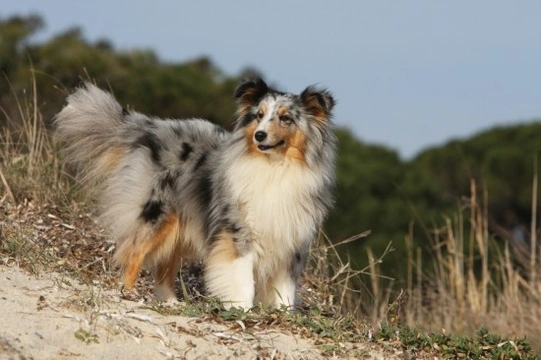
The blue merle Shetland sheepdog gene and what it means for dogs
The blue merle colouration within the Shetland sheepdog (or sheltie) breed is one of the most visually impressive and beautiful colours available, but it also comes with a range of potential complications. Blue merle colouration is not one of the natural breed colours, but instead is caused by a genetic mutation, that comes with a range of other indicators as well as the colour of the coat. The gene for blue merle is recessive, meaning that if only one of the parent dogs carries the gene, the subsequent puppies are unlikely to display the blue merle traits. However, if both parents carry the gene, the chances are that some or all of their puppies will carry it too, and with this comes a range of potential health problems.
The merle gene can lead to potential hearing and vision problems in affected puppies, and so it is important to understand what the gene does and the issues it can cause before seeking to own a blue merle coloured Shetland sheepdog. Read on to learn more about this.
More about the gene that causes blue merle colouration
The Shetland sheepdog can be found in a range of different accepted colours, including tricolour black, white and tan, brown and white, black and white, grey merle, and various other mixtures.
The colours of the puppies in any Shetland sheepdog litter will be determined by the colours of the two parent dogs, and to a lesser extent, the colours of their ancestors that have been passed down into the gene pool. Dogs may have the components of certain genes that are considered to be recessive, meaning that while the colour caused by the gene is not always present and visible on the parent dogs, they still carry the gene. This is known as having a single blue merle gene, and of course, without examining the ancestral breed line, it is not always possible to know if any given dog is a carrier. A dog that carries a single blue merle gene may appear in blue merle colouration without any other indicators of the gene, or may come in the normal Shetland sheepdog colours.
However, if two dogs, each with one blue merle gene are bred, this produces puppies that carry a double merle gene, meaning that the puppies will carry the gene and display its traits too, such as the blue merle colour and the associated disorders that affect hearing and eyesight.
How are blue merle Shetland sheepdogs bred?
When one parent dog carrying the merle gene is bred to a dog that does not carry the gene, the colour pattern produced in the puppies is not properly blue, but rather, the black pigment within the dog’s coat is diluted to a silvery or grey shade. Blue merle Shetland sheepdogs always have some tan areas to their coats, while a white, black and grey merle dog without any tan areas is known as a bi-blue. This is the colouration that is achieved from breeding one dog with the merle gene with another that does not have it.
The problem with inheriting the double blue merle gene
It can be difficult to identify at a glance the results of a breeding of double merle gene dogs, but such breeding usually results in some health issues that can be detected in and of themselves.
The double merle gene generates a pigment disorder, which, as well as affecting coat colour, also causes the colour and shape of the eyes, and the development of the nerve endings in the inner ear to develop abnormally. This means that puppies and dogs that inherit the double merle gene and coat colour will also have light blue coloured eyes, and potential vision problems on a sliding scale that can extend as far as blindness. Hearing difficulties or total deafness may also accompany the gene.
As the blue merle puppy grows and develops, this may be evinced by poor depth perception or night vision, apparent clumsiness and bumping into things, or problems focusing clearly. Your dog may also display the obvious signs of deafness or hearing problems, such as not hearing you when you call them, and not reacting to loud or sudden noises.
How can you tell if the merle gene is present?
The breeder of the Shetland sheepdog should keep ancestral records of the dogs that they use for breeding, in order to identify the presence or absence of the blue merle gene, and which dogs and puppies may carry it. This means that breeders should avoid breeding dogs that carry the gene, and particularly, avoid breeding two dogs that carry the gene with each other.
It is not possible to accurately tell the gene makeup of any dog from the colour of their coat alone, and the only way to definitively find out the presence or absence of the gene is by looking at the ancestry of the dogs, or performing genetic testing to identify the blue merle gene.



